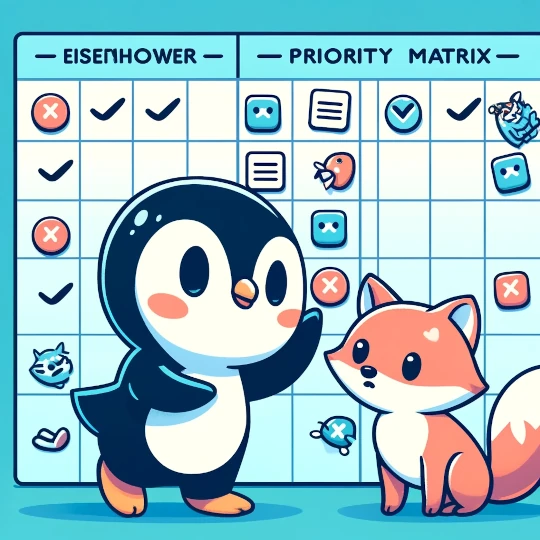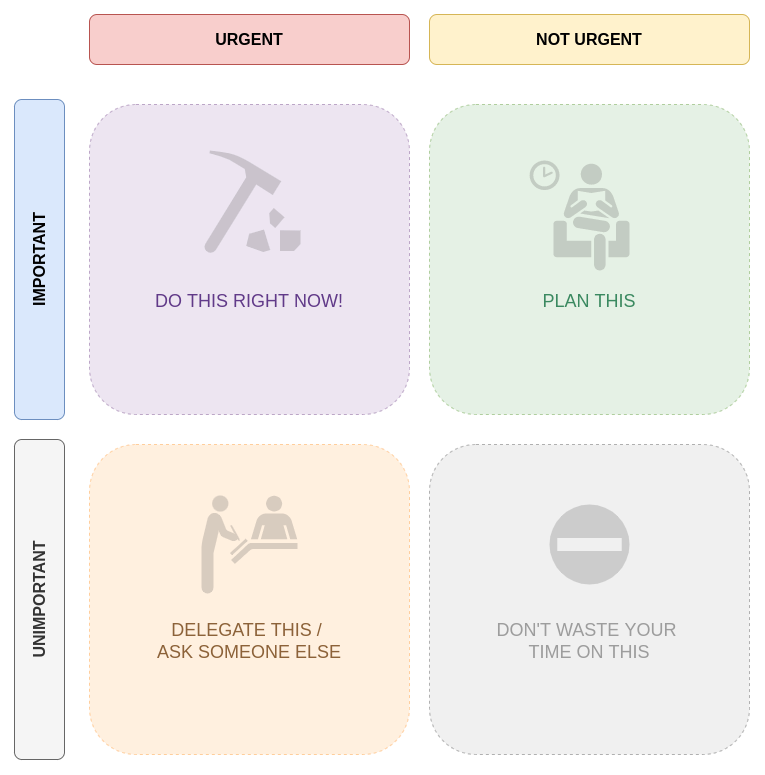Get your priorities straight
Meta Info

Problem Statement
You find yourself constantly busy, yet achieving little of value.
Intent
- Priorities can change when the facts change.
- You know which tasks you should pick up first.
- You have peace of mind as tasks you need to do are not forgotten.
Contextual forces
These describe factors at play that influence the outcome of the practice. They are not necessarily good or bad, but they are important to be aware of.
Enablers
The following factors support effective application of the practice:
- You can decide and manage your tasks.
- You are aware of your personal goals and ambitions.
- You always have a notebook (digital or analogue) close by.
- You can communicate your intent to people effectively.
Enablers
The following factors support effective application of the practice:
- You do not know what your goals and ambitions are.
- You find it hard to rank tasks according to their importance.
- You are unable to consistently apply a prioritization technique.
- Others frequently dictate the individual’s tasks and priorities (micromanagement).
Solution
Ensure your tasks have a clear order by assigning properties to them, allowing you to prioritize effectively. The Eisenhower Priority Matrix, a well-known technique, can be a great starting point. This allows you to work down your list starting with the task with the highest priority and working your way down. Working in this way ensures that your most important tasks get done first. Anything left behind (due to a lack of time) is, by definition, less important than the items you have already worked on. This ensures that you get as much of the “important stuff” done as you can in the time available.
Various prioritization techniques exist, and you are – of course – free to use whichever one you like. To get you started, however, I included a well-known technique below. This technique is known as the “Eisenhower Priority Matrix” and is very simple to use.
Eisenhower priority Matrix
Organize your action items according to:
- their importance: actions can be either
importantorunimportant - their urgency: these are either
urgentornot urgent
This leaves you with a nice 2-by-2 grid in which to place your actionable items[^3].
Each grid section corresponds to a specific way to handle the action items contained within:
- eliminate or ignore the things that are
unimportantandnot urgent. Because Who cares abut these anyway? The items in this quadrant are known as “distractions” or “busy work”. - delegate the
unimportantandurgentstuff. Something should be done about them fast, but you probably don’t need to be the person working on them. - plan / schedule the
importantandnot urgentitems. These are the things that you would really like to do, but never seem to get around to doing. Setting a specific date on which you will act upon these items will help you get them done eventually. Just make sure to stick to your schedule. - Do these NOW!:
importantandurgent… what are you waiting for? Start working on these immediately. Just make sure these are important to YOU and you are not being swayed by someone else’s urgency.
Using the matrix
When adding tasks to your matrix, remember not to adopt someone else’s urgency as your own. Not every task is yours to resolve; use your judgment to prioritize based on your goals and commitments. While certain requests might be important and urgent to someone else, they might not be to you. As an example: consider an acquaintance that calls you on a Friday evening, trying to convince you to fix their computer. Is this urgent? To them, probably. To you? Probably not. If you did not make any other plans, you can consider helping them. If you have other things to do, this would be categorized as “urgent, not-important.”
Rationale
- Having too many things on our mind stresses us out.
- Our memories are lossy; We tend to forget about things all the time.
- Standard to-do lists have no readily available means of prioritizing items.
- Multitasking is hard. Our brains work better if we can compartmentalize between different modes of thinking (planning and executing).
Considerations
- Over-emphasis on Structure: The structured approach may lead to rigidity and reduced flexibility in task management. It introduces the risk of overlooking emergent tasks or opportunities.
- Rigidity: Applying a strict prioritization technique may limit adaptability and creativity in task management. It introduces the danger of seeing the categorization as a fixed property of the task, rather than as a temporary assessment.
- Focus on Urgency and Importance: The technique may lead to neglecting tasks that are not urgent but are important in the long term.
- Subjectivity in Prioritization: The importance and urgency of tasks can be subjective, leading to potential biases in prioritization. The technique may lead to neglecting tasks that do not fit neatly into the matrix categories, potentially limiting creativity and adaptability in task management.
- Dependence on Personal Goals: The effectiveness of the technique depends heavily on having clear personal goals and ambitions.
Mitigation Strategies
- Scheduled Reviews: Set regular intervals for reviewing and updating the priority matrix to keep it relevant and manageable. Ensure you re-prioritize tasks based on changing circumstances and goals.
- Goal Clarification: Regularly review and clarify personal goals to ensure effective use of the prioritization technique.
- Avoid Peer Pressure: Ensure the prioritization is based on personal goals and commitments, rather than external pressures or expectations. Clearly communicate your goals and boundaries to others. This will help reduce the influence of external demands on your decision-making process.
- Combine Tools: Use the matrix in conjunction with other task management tools, such as To-Do list and personal planners, to balance structure and flexibility in task prioritization.
- Use as a Guideline: Treat the matrix as a guideline rather than a strict rule, allowing for adaptability in task prioritization. Use multiple prioritization techniques to balance structure and flexibility in task management.
Further Exploration
- Allen, D. (2015). Getting Things Done: The Art of Stress-Free Productivity. Penguin Books. isbn: 0143126563.
https://www.goodreads.com/book/show/22573850-getting-things-done. - Covey, S. R.; Collins, J. (2004). The 7 Habits of Highly Effective People: Powerful Lessons in Personal Change. Free Press. isbn: 0743269519.
https://www.goodreads.com/book/show/36072.The_7_Habits_of_Highly_Effective_People. - Unknown (2023). What is the Eisenhower Matrix?. productplan.com.
https://www.productplan.com/glossary/eisenhower-matrix/.
